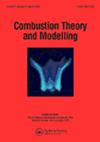Coflow filtration combustion waves
IF 1.6
4区 工程技术
Q4 ENERGY & FUELS
引用次数: 0
Abstract
Recently, it has been proposed to develop space power systems based on filtration combustion of metal powders with oxygen supplied by a chemical oxygen generator. The experiments with lithium and magnesium powders at natural infiltration of oxygen have shown propagation of both counterflow and coflow combustion waves. However, natural filtration combustion of metal powders at relatively low pressures is not sufficiently understood. In the present paper, we investigate the natural coflow combustion waves propagating through a porous medium. The porous matrix is made of metal particles that react with oxygen flowing from the open end of the sample to the reaction zone where it is consumed forming a condensed product which also has a porous structure. The gas flow is due to the pressure difference between the pressure at the open end and that in the reaction zone (the so-called natural filtration). The open end is where the sample is ignited, so that the gas flows through the reaction products, i.e. in the same direction as the combustion wave propagates (coflow filtration). Our mathematical model involves the conservation of energy equation and gas mass, solid reactant mass, and gas momentum balances, as well as an equation of state, and appropriate boundary and initial conditions. It is studied analytically under the combustion front approximation. When the reaction zone is close to the open end, there is sufficient amount of oxygen in the reaction zone and the reaction is controlled by kinetic factors (the kinetic regime of propagation). As the reaction moves away from the open end, it is gas supply that becomes a limiting factor (filtration regime). Both kinetic and filtration regimes of propagation as well the transition between them are analytically studied in this paper.Coflow过滤燃烧波
本文章由计算机程序翻译,如有差异,请以英文原文为准。
求助全文
约1分钟内获得全文
求助全文
来源期刊

Combustion Theory and Modelling
工程技术-工程:化工
CiteScore
3.00
自引率
7.70%
发文量
38
审稿时长
6 months
期刊介绍:
Combustion Theory and Modelling is a leading international journal devoted to the application of mathematical modelling, numerical simulation and experimental techniques to the study of combustion. Articles can cover a wide range of topics, such as: premixed laminar flames, laminar diffusion flames, turbulent combustion, fires, chemical kinetics, pollutant formation, microgravity, materials synthesis, chemical vapour deposition, catalysis, droplet and spray combustion, detonation dynamics, thermal explosions, ignition, energetic materials and propellants, burners and engine combustion. A diverse spectrum of mathematical methods may also be used, including large scale numerical simulation, hybrid computational schemes, front tracking, adaptive mesh refinement, optimized parallel computation, asymptotic methods and singular perturbation techniques, bifurcation theory, optimization methods, dynamical systems theory, cellular automata and discrete methods and probabilistic and statistical methods. Experimental studies that employ intrusive or nonintrusive diagnostics and are published in the Journal should be closely related to theoretical issues, by highlighting fundamental theoretical questions or by providing a sound basis for comparison with theory.
 求助内容:
求助内容: 应助结果提醒方式:
应助结果提醒方式:


